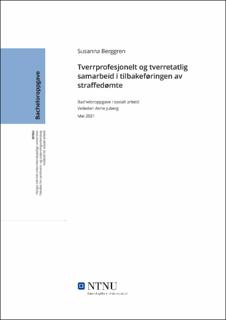| dc.contributor.advisor | Juberg, Anne | |
| dc.contributor.author | Berggren, Susanna | |
| dc.date.accessioned | 2021-09-28T18:46:50Z | |
| dc.date.available | 2021-09-28T18:46:50Z | |
| dc.date.issued | 2021 | |
| dc.identifier | no.ntnu:inspera:79529603:34883623 | |
| dc.identifier.uri | https://hdl.handle.net/11250/2785728 | |
| dc.description.abstract | Statistikk viser at innsattes levekår er dårligere enn befolkningen generelt, og problemene deres er mer komplekse. Studiene jeg har sett på viser at i arbeid med innsatte med komplekse problemer er ofte tverrprofesjonelt og tverretatlig samarbeid enn nødvendighet.
Problemstillingen som oppgaven skal besvare er:
Hvordan kan tverrprofesjonelt og tverretatlig samarbeid bidra til tilbakeføringen av straffedømte til samfunnet?
Dette er en teoretisk oppgave hvor jeg har brukt metodikken som hører til litteraturstudie for å finne fram til relevante kilder. Problemstillingen har jeg drøftet i lys av den teorien, litteraturen og forskningen som jeg har funnet.
I oppgaven har jeg gått i dybden på hvorfor det kan være nødvendig med tverrprofesjonelt og tverretatlig samarbeid, og hvilke utfordringer og muligheter det kan gi. Jeg tar blant annet utgangspunkt i Maslows behovspyramide for å belyse hvorfor det er viktig å ta en individuell vurdering av de innsatte, og hvorfor det er viktig å se dens problemer i sammenheng. Jeg har sett på importmodellen og hvordan den har satt grunnlaget for mye av det tverretatlige samarbeidet i fengsel. Jeg har også gått inn på ulike modeller for organisering av samarbeid, og hvordan bruken av dem har betydning for nytten man får av samarbeidet i tilbakeføringen.
Denne bacheloroppgaven viser at tverrprofesjonelt og tverretatlig samarbeid har potensialet til
å bidra til en god tilbakeføring av innsatte, om det blir brukt rett. Om en får dette til kan det
få et positivt utfall for de innsattes mulighet til å få jobbet med sine grunnleggende behov, og
videre til å leve et liv uten kriminalitet. | |
| dc.description.abstract | Statistics show that the inmates’ living conditions are generally worse than the general population, and their problems are more complex. The studies that I have examined show that when you are working with inmates with complex problems, interprofessional and interorganisational collaboration can be necessary.
The research question in this paper is:
How can interprofessional and interorganisational collaboration contribute to the return of convicts to the community?
This is a theoretical assignment where I have used the methodology of a literature study to find relevant sources. I have then discussed the research question in the light of the theory, literature, and research that I found.
In this assignment I have explored why it sometimes is necessary to use interprofessional and interorganisational collaboration, and what challenges and opportunities that can present. Among other things I will be using Maslows hierarchy of needs to shed a light on why it is important to do an individual assessment of the inmates, and why it is important to see the problems in connection with each other. I have looked into the import-model, and how it has made the fundament for the interorganisational collaboration in prison. I have also taken a look into different models for organizing collaboration and how the use of them can impact the benefit of using collaboration in the return to community.
This bachelor thesis indicates that interprofessional and interorganisational collaboration has the potential to contribute to a successful return of the inmates, if it is used properly. If this is done correctly, it can have a positive outcome for the inmates’ possibilities to work with their basic needs, and to live a life without crime. | |
| dc.language | nob | |
| dc.publisher | NTNU | |
| dc.title | Tverrprofesjonelt og tverretatlig samarbeid i tilbakeføringen av straffedømte | |
| dc.type | Bachelor thesis | |
